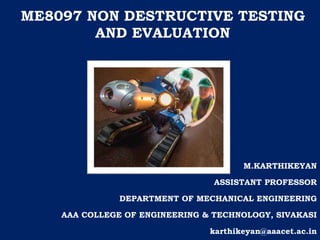L1 ndt versus mechanical testing &; overview of liquid penetrant test
•
1 recomendación•212 vistas
L1 ndt versus mechanical testing &; overview of liquid penetrant test
Denunciar
Compartir
Denunciar
Compartir

Recomendados
Recomendados
Más contenido relacionado
La actualidad más candente
La actualidad más candente (20)
Non Destructive Testing Versus Destructive Testing

Non Destructive Testing Versus Destructive Testing
Visual inspection and optical aids for visual inspection application

Visual inspection and optical aids for visual inspection application
Mechanical Engineering Technical Interview Q & A_Press tools PDF

Mechanical Engineering Technical Interview Q & A_Press tools PDF
screw thread terminology and measurement by optical profile projector

screw thread terminology and measurement by optical profile projector
Similar a L1 ndt versus mechanical testing &; overview of liquid penetrant test
Similar a L1 ndt versus mechanical testing &; overview of liquid penetrant test (20)
Non Destructive Testing (NDT), Testing of Materials

Non Destructive Testing (NDT), Testing of Materials
Más de karthi keyan
Más de karthi keyan (20)
cme397 surface engineering unit 5 part A questions and answers

cme397 surface engineering unit 5 part A questions and answers
types (classification) of cutting tool materials.docx

types (classification) of cutting tool materials.docx
difference between orthogonal vs oblique cutting.docx

difference between orthogonal vs oblique cutting.docx
characteristics of films - graininess, density, speed, contrast

characteristics of films - graininess, density, speed, contrast
Último
Último (20)
NO1 Top No1 Amil Baba In Azad Kashmir, Kashmir Black Magic Specialist Expert ...

NO1 Top No1 Amil Baba In Azad Kashmir, Kashmir Black Magic Specialist Expert ...
Block diagram reduction techniques in control systems.ppt

Block diagram reduction techniques in control systems.ppt
PE 459 LECTURE 2- natural gas basic concepts and properties

PE 459 LECTURE 2- natural gas basic concepts and properties
DC MACHINE-Motoring and generation, Armature circuit equation

DC MACHINE-Motoring and generation, Armature circuit equation
Standard vs Custom Battery Packs - Decoding the Power Play

Standard vs Custom Battery Packs - Decoding the Power Play
Double Revolving field theory-how the rotor develops torque

Double Revolving field theory-how the rotor develops torque
1_Introduction + EAM Vocabulary + how to navigate in EAM.pdf

1_Introduction + EAM Vocabulary + how to navigate in EAM.pdf
"Lesotho Leaps Forward: A Chronicle of Transformative Developments"

"Lesotho Leaps Forward: A Chronicle of Transformative Developments"
A CASE STUDY ON CERAMIC INDUSTRY OF BANGLADESH.pptx

A CASE STUDY ON CERAMIC INDUSTRY OF BANGLADESH.pptx
Tamil Call Girls Bhayandar WhatsApp +91-9930687706, Best Service

Tamil Call Girls Bhayandar WhatsApp +91-9930687706, Best Service
L1 ndt versus mechanical testing &; overview of liquid penetrant test
- 1. OML751 TESTING OF MATERIALS ME8097 NON DESTRUCTIVE TESTING AND EVALUATION M.KARTHIKEYAN ASSISTANT PROFESSOR DEPARTMENT OF MECHANICAL ENGINEERING AAA COLLEGE OF ENGINEERING & TECHNOLOGY, SIVAKASI karthikeyan@aaacet.ac.in
- 2. UNIT I OVERVIEW OF NDT 1. NDT Versus Mechanical testing & Overview of Liquid penetrant test 2. Overview of Magnetic particle test 3. Overview of Thermography test 4. Overview of Eddy current test 5. Overview of Ultrasonic test 6. Overview of Acoustic emission test 7. Overview of Radiographic test 8. Various physical characteristics of materials and their applications in NDT., 9. Visual inspection – Unaided and aided.
- 4. DESTRUCTIVE TEST NON DESTRUCTIVE TEST 1 Used for finding out the properties of the material Used for finding out defects of materials 2 Load is applied on the material Load is not applied on the material 3 Due to load application, material gets damaged No load applications, so no chance for material damage 4 Tested material cannot be reused. Tested material can be reused. 5 Tests are mostly quantitative measurements. Tests are mostly qualitative and rarely quantitative measurements. 6 All measurements are direct Most of the measurements are
- 5. DESTRUCTIVE TEST NON DESTRUCTIVE TEST 7 In – service inspection is not possible In – service inspection is possible 8 Specimen preparation is necessary. Little or no specimen preparation is required. 9 Can measure only one property at a time. Can measure many parameters. 10 Time conception for inspection is more. Rapid inspection is possible 11 Skilled man power is not required to interpret the results Skilled man power is required to interpret the results
- 6. OVERVIEW OF LIQUID PENETRANT TEST
- 7. LIQUID PENETRANT TESTING INTRODUCTION: Used to detect the surface discontinuities in non porous solids. Can be used for both ferrous and non-ferrous materials. Used to detect casting, forging and welding surface defects such as hairline cracks, surface porosity, leaks in new products and fatigue cracks.
- 8. INSPECTION PROCEDURE: Pre-cleaning Application of penetrant Excess penetrant removal Application of developer Inspection Post cleaning
- 12. ADVANTAGES High sensitivity Small discontinuities can be detected Metallic, non-metallic, magnetic, non-magnetic, conductive and non-conductive materials may be inspected. Rapid Inspection of large areas Suitable for complex shapes Indications are produced directly on the surface Indications can reveal relative size, shape, and depth of the flaw Portable Low cost It is easy and requires minimal amount of training
- 13. DISADVANTAGES Only surface and near surface defects can be detected Only non-porous surface can be inspected Pre-cleaning is critical Post cleaning is required Chemical handling and proper disposal is required. Surface finish and roughness can affect inspection sensitivity. Fumes can be hazardous and flammable without proper ventilation
- 14. PART - A 1. Distinguish between destructive testing and non destructive testing(UN, CO1) PART - B 1. Explain the sequence of operations of liquid penetrant testing 2. Compare the destructive testing methods and non-destructive testing methods with respect to its advantages and limitations QUESTIONS